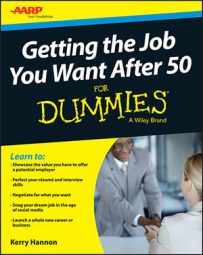Copyright © 2015 AARP. All rights reserved.
When you reach your 50’s, you may decide it’s time to relaunch a career that was placed on hold earlier in life. Many women (and increasingly men) decide to step out of the workforce to stay home and raise their kids or care for a relative. A decade hence, when they want to return to the workforce, they often discover that doors aren’t swinging open. Why? Several reasons:
Technology has changed radically in the past decade. Odds are the job you had is handled a lot differently these days.
Even with a strong economy, it takes a 55-year-old worker almost a year to land a job after losing one, according to the U.S. Bureau of Labor Statistics.
Age discrimination is alive and well. Like it or not, this ugly phenomenon is a fact at many companies. A recent AARP survey found that nearly one in five people age 45 to 74 believe they didn’t get hired because of their age.
The corporate world values work experience, and no matter how you spin the story about your PTA service and volunteer work, staying home with the kids doesn’t qualify as work experience in the eyes of many employers. You need to showcase the experience in a positive way. You can show how you can prioritize work issues or delegate tasks. Now is the time to get creative!
It’s usually easier to get a job if you never left the workforce entirely. If not, here are some tips to help you return to the workforce:
Pump up your networking. Yes, this really works. Networking isn’t necessarily going to land you a job tomorrow; it’s a process of developing contacts gradually.
Show interest in what other people are up to and learn from them. When you attend a networking event, spend twice as much time listening as talking, with a goal of meeting at least three new people and getting their contact information.
Freelance or contract to get back up to speed. Become a freelancer or contract worker, at least for the time being, to refresh your skills, get current and relevant job experience and references, and expand your professional network.
Add skills and certificates. Not up on the latest technology or changes in your former field? Sign up for classes and make an investment in your future. A specialized professional certificate from a community college or trade association (with classes that you can take in person or online) may be the card you need to punch. Learning Advisor, powered by Kaplan in partnership with AARP’s LifeReimagined.org, offers information about certificates, degrees, and scholarships.
Dive into the social media pool. Get comfortable with and use LinkedIn, Twitter, and Facebook. Employers expect it.
Look for jobs at small companies. Small companies and businesses can’t always afford to lure top-level talent with sweet benefits like stock options, 401(k) plans, and generous health insurance, so they may be thrilled to snag someone as sharp as you.
Volunteer. Meaningful volunteering can be an excellent way to eventually land a job. You can demonstrate your skills helping out at a nonprofit and then tout your accomplishments when applying for a paid position. You may even wind up getting hired at the organization where you volunteer. A few recent surveys have shown that volunteering helps job candidates find work.

